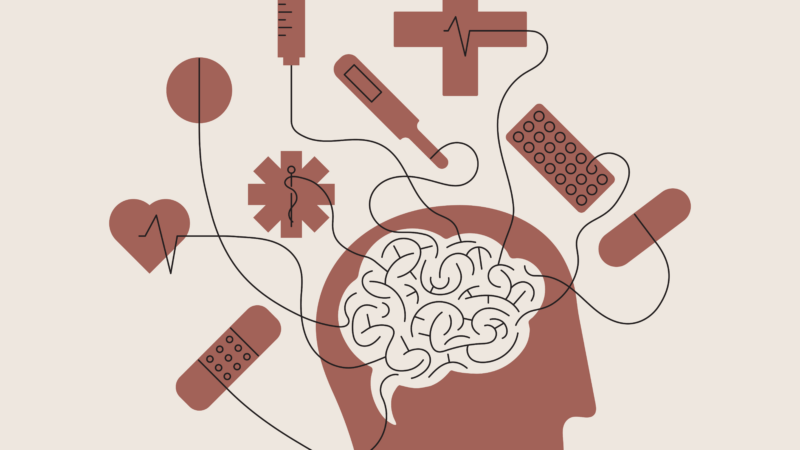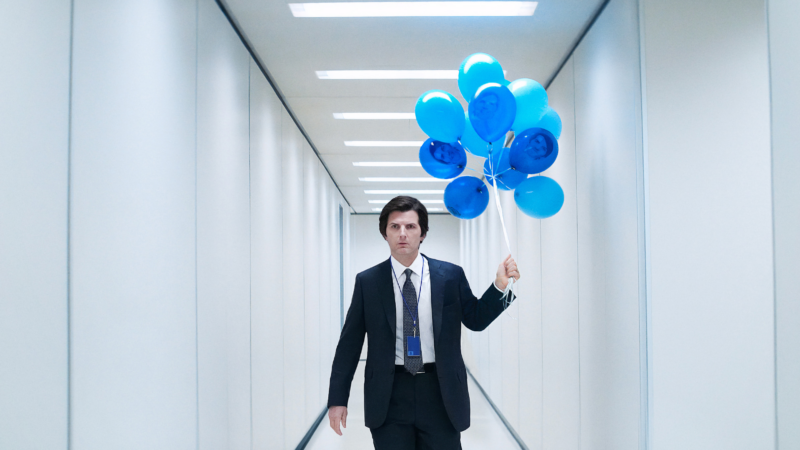Stay away from Dr. Google, and other lessons learned about hypochondria
If you’ve ever Googled a list of health symptoms — and become convinced you have a serious illness and are doomed — you might be suffering from hypochondria. Author Caroline Crampton wrote A Body Made of Glass: A Cultural History of Hypochondria, because she’s pretty sure she has it.
“It’s a fear that can’t be substantiated by any medical tests you might do,” Crampton says of hypochondria, which is now known medically as illness anxiety disorder. “The definition that I like, and that I use, comes from the Oxford English Dictionary. And it runs, ‘a mental condition characterized by the persistent and unwarranted belief or fear that one has a serious illness.'”
Crampton developed excessive health anxiety after being treated for blood cancer in her teens. Though the cancer went into remission, it returned a year later. She has since undergone several therapies for her health anxiety.
Crampton says hypochondria can manifest as illness anxiety and/or somatic symptoms. In the former, patients suffer from excessive hypervigilance and anxiety around potential health problems. Somatic symptom disorder, meanwhile, includes anxiety, but “adds this extra thing of phantom symptoms,” she says.
Of course, sometimes symptoms really do point to an underlying physiological problem and need medical treatment. Crampton says she doesn’t hesitate to have a doctor check out symptoms that she’s worrying over. Because of her serious medical history, she says doctors usually treat her concerns with respect. But says she knows that many people have experienced doctors disbelieving them or writing off their concerns as merely anxiety, “only to have a serious diagnosis later on that could have been caught much earlier.”

The Internet can stoke hypochondria by offering access to seemingly limitless information about health conditions, but Crampton notes that the condition predates the information age. In fact, her book takes it’s title from “glass delusion,” a centuries-old psychological disorder in which people — including the French King Charles VI — suddenly think their bodies are made of glass.
“I don’t think the glass delusion is hypochondria,” she says. “But the more I became fascinated by [glass delusion] and researched it, the more I began to think that it was a very good image or metaphor for what it feels like to have hypochondria, because the sufferers from the glass delusion were absolutely obsessed with the idea that they were breakable and fragile.”
Interview highlights

On how the Internet can stoke “cyberchondria”
I try and restrict myself. I don’t not look at the Internet in relation to my health, but I limit myself only to reputable sources, in particular here in the U.K., the NHS website has a very, very wide ranging catalog of illnesses and connects all the symptoms together and will allow you to click through and see how things relate to each other. So that’s my first port of call. I look at the NHS website, I know it’s evidence-backed and I know it will tell me: “If you think you have this, please go to the doctor,” and so on. And yeah, there is a shortlist of others that I take the same approach to. What I try not to do — I would say I never do it — is just type symptoms into Google … with no sort of guardrails at all because that’s where I can easily find myself falling down a spiral and getting into a really bad place mentally.
On being care-seeking vs. care-avoidant
People fall into either care-seeking or care-avoidant. People tend to be very polarized. I’m definitely care-seeking. I think whether it’s helpful or not often depends on the type of doctor that you see. I’ve seen some incredibly helpful doctors and I’ve seen some incredibly unhelpful ones. So in some ways it feels a bit like the luck of the draw. You never know quite what you’re going to get. But I think I would always encourage people to seek medical help if they have a reason to do so, if that makes sense. I, on balance, feel it’s always better to go than not go.
I do my best to take medical personnel at face value, if that makes sense. And I try and do this test in my mind of: If it’s serious enough for me to worry about, then it’s serious enough for me to go to the doctor. And if it’s serious enough again, I’ll go to the doctor again. … I’m there in good faith. I try and assume that the doctor or the medical professional is there in good faith, too. And if they’re not, I will just go back and ask for a second opinion.
On how medical professionals have reacted to her illness anxiety
Almost all of the time I find myself taken very seriously. Sometimes a little voice in my head says, “maybe too seriously.” Maybe occasionally I could benefit from being told, “It’s nothing to worry about. You can go home.” I think because of my serious medical history and the fact that my medical file is like half a foot wide, I feel like every single little thing that I even vaguely mentioned gets tested, which is in some ways an incredibly fortunate thing to happen.
On the relationship between hypochondria and PTSD
I spoke to some people when I was working on the book … such as someone who was a twin, and her twin had had some quite serious childhood illnesses that required them to be hospitalized. She, the other twin, had been completely healthy. But watching her twin go through that … as an adult surfaced for her as hypochondria. Other people who had a very close friend pass away young from a serious condition. And then after … that trauma, they had then developed anxiety about their health, having previously never suffered from it before. So it feels like an idea that checks out to me that you might respond to a really traumatic event by developing the anxiety that something similar might be going to happen to you in the future.
On cognitive behavioral therapy treatment and hypochondria
CBT was really helpful for the small day-to-day problems such as Googling your symptoms and reading health-related stuff on the Internet, or watching too much wellness things on Instagram, or spending too long checking on your moles, that kind of thing. That can be really helpful in changing those kinds of daily behaviors. So the exercise is mostly just not doing them for long periods of time and having to record every time you felt the impulse to do it and how you were feeling at the time. So that it was very helpful to be able to associate, I’m feeling anxious about this work thing I’ve got coming up, I seem to be checking WebMD a lot more than I normally would. Maybe those things are related. So it was very helpful for things like that.
On her new appreciation for her body
Until my diagnosis when I was 17, I very much thought of myself as a brain in a jar. I thought the only part of me that would ever produce any value was in my mind and that [my] body was just the way I moved the mind around the world. It would never do anything remarkable. Since going through all the treatment as difficult and traumatic as it was at times, I did come out of it with this incredible appreciation for the myriad complexities of the human body. …
Sometimes I feel a bit like if you go into a really incredible building, like a cathedral or a civic hall and you have this feeling of awe that while, wow, someone conceived of this design and then it was built and now I can stand inside it, I sometimes feel that a sense of awe, a bit like that, thinking of my own body, strange as that sounds, I kind of look at it. Wow, look at what it’s doing. I’m not even thinking about this. I’m not making it do any of this. Look how magnificent it is. So it has given me this slightly cheesy appreciation for what the human body can do and made me a little bit more interested.
Sam Briger and Thea Chaloner produced and edited this interview for broadcast. Bridget Bentz, Molly Seavy-Nesper and Carmel Wroth adapted it for the web.
Photos: Thousands in Los Angeles evacuate as wind-fueled Palisades Fire quickly worsens
More than 30,000 people in Los Angeles County have been ordered to evacuate as the Palisades Fire blazed through the Pacific Palisades community, fueled by intense Santa Ana winds.
Man who exploded Cybertruck in Las Vegas used ChatGPT in planning, police say
The highly decorated soldier who exploded a Tesla Cybertruck outside the Trump hotel in Las Vegas used generative AI including ChatGPT to help plan the attack, Las Vegas police said Tuesday.
Wild weather brings snow to the South and Santa Ana winds to the West
As the South prepped for snow and more cold starting Wednesday, residents in Southern California faced off with hurricane-strength winds.
What to know about Trump and his keen interest in Greenland
President-elect Donald Trump has said multiple times that the U.S. should buy Greenland, an autonomous territory of Denmark. The sparsely populated island is geopolitically important and mineral-rich.
There’s great TV coming in January, from ‘Severance’ Season 2 to a Jerry Springer doc
There is a lot of TV on deck in the new year – including multiple medical dramas, a violent Netflix drama about Utah settlers in the 1850s, plus, cop shows, Westerns and documentaries.
Life-threatening windstorm triggers wildfire in Southern California
Southern California hasn't seen significant rainfall since last April, and a pileup of dry fuel in combination with the winds has the region on edge. A mandatory evacuation order was issued for the Palisades.







